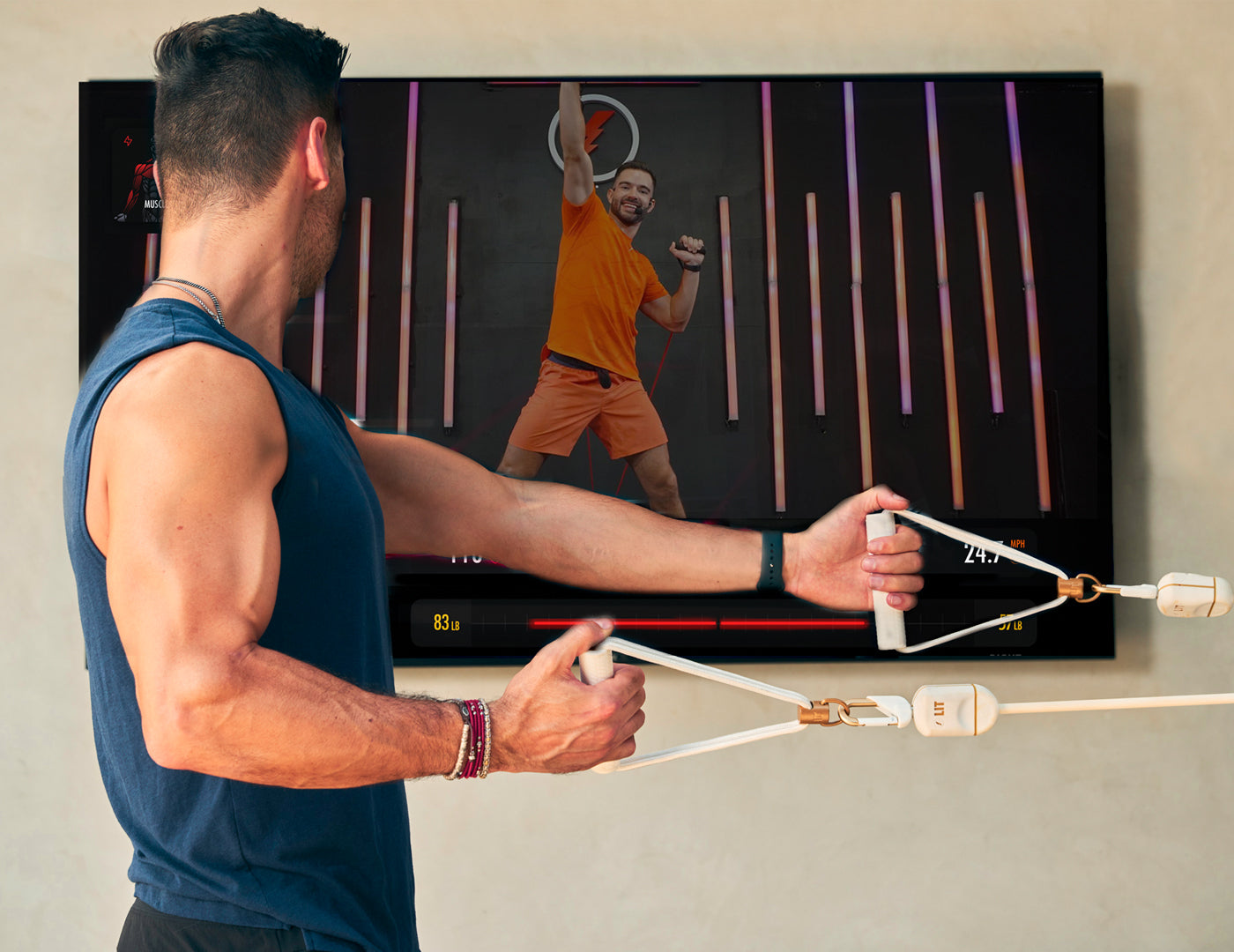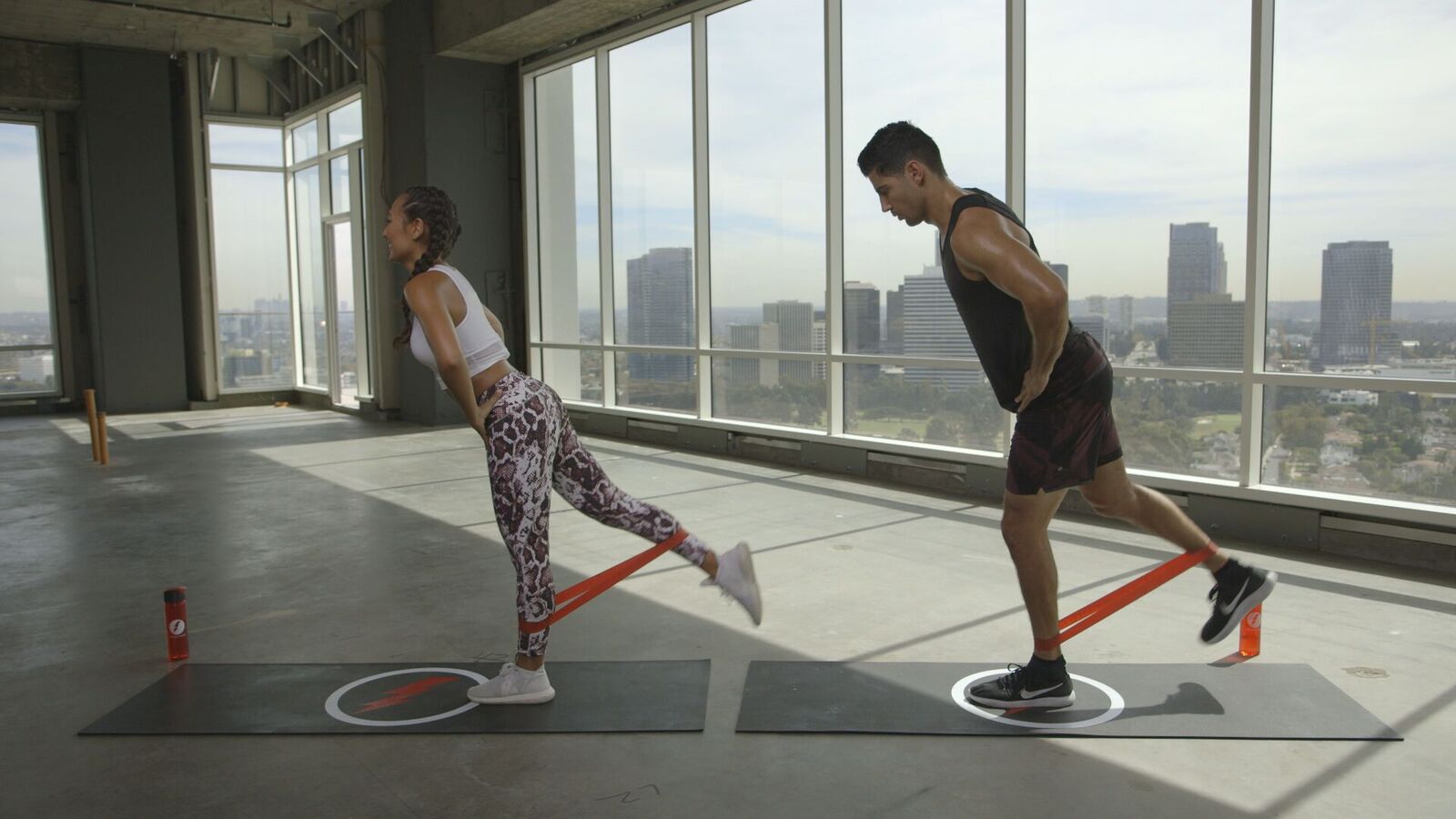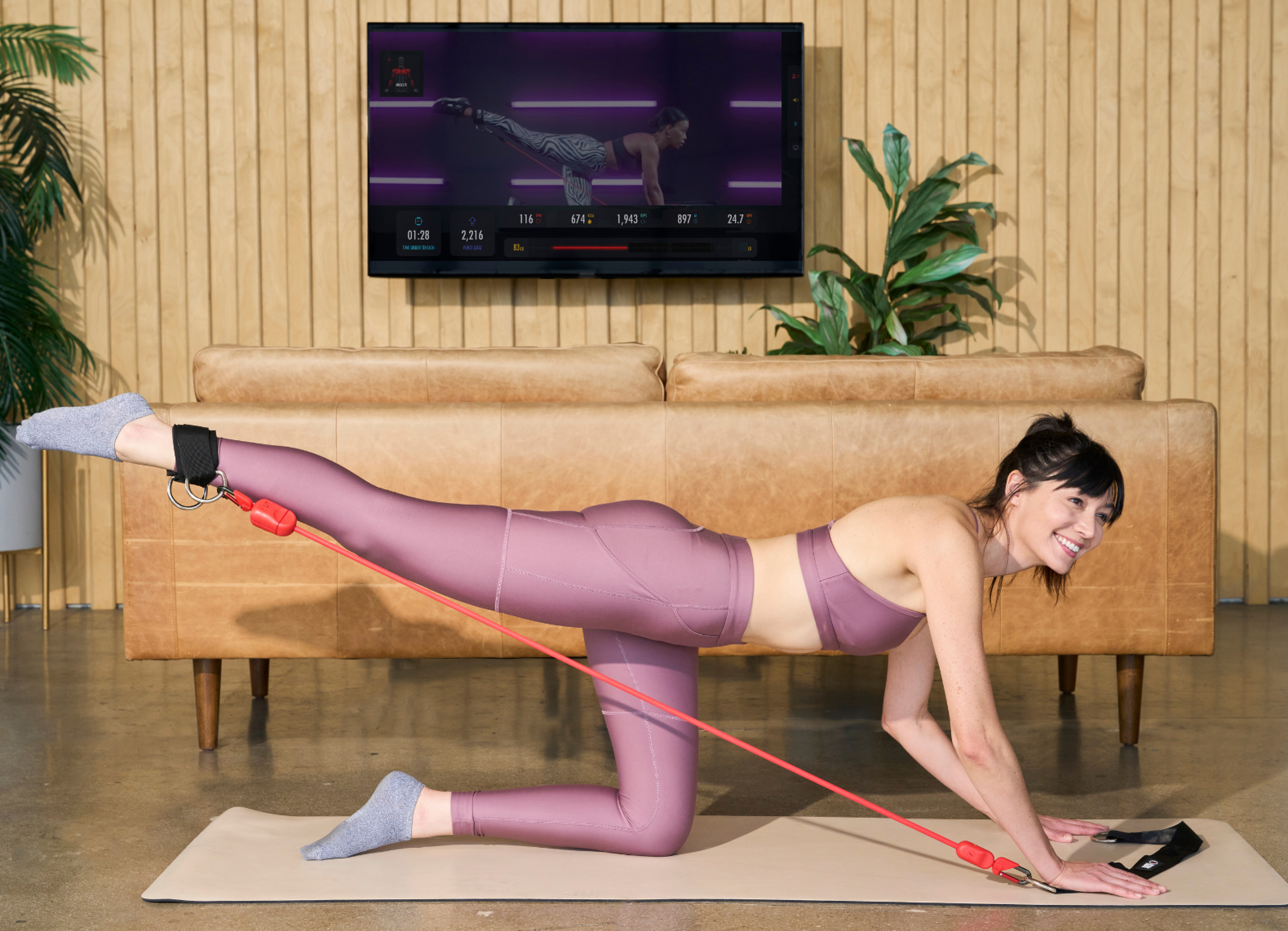Shoulder injuries can significantly impact our ability to perform daily tasks and engage in physical activities. Resistance bands can be a valuable addition to your fitness routine if you are recovering from a shoulder injury. The rotator cuff resistance band exercises are great for shoulder rehabilitation and promote shoulder stability, flexibility, and strength.
Resistance bands are great because they allow controlled motion without overloading the shoulder joints like free weights. Shoulder band rehab exercises are low-impact, minimizing the risk of injuries. Here are the best rotator cuff resistance band exercises for you.
Shoulder Rehab Exercises with resistance bands
1. Front Raise
- Stand at the center of the resistance band with your feet shoulder-width apart.
- Grasping handles with opposite hands and palms facing your thighs, slightly bend your knees.
- Keep your arms straight and slowly raise them in front of you until your arms are parallel to the ground.
- Hold and then slowly lower your arms back down.
- Repeat for 10-15 reps for 2-3 sets.
2. Lateral Raise

- Stand on the resistance band with your feet shoulder-width apart.
- Hold the band with opposite hands, palms facing your body, and stand upright.
- With your arms straight, lift them to the sides, stretching the resistance band across your body until they are parallel to the ground.
- Slowly lower your arms back down.
- Do 3 sets of 10-15 reps.
3. Reverse Fly

- Place one knee on the resistance band and start in a table top position.
- Hold the band handle with your opposite stabilize your body.
- Engaging your core, open your arms wide, pulling the band apart as you squeeze your shoulder blades together.
- Hold at the top and then slowly return to the starting position.
- Do 12-15 reps for 2-3 sets switching sides.
4. Standing Row

- Anchor the resistance band at your chest height.
- Stand with your feet hip-width apart, hold handles firmly, and hands fully extended in front of you.
- Bend your elbows and pull the band towards your ribcage, squeezing your shoulder blades together. Ensure your back is not slouching or your chest moving forward.
- Gradually extend your arms back to the starting position.
- Perform 10-12 reps for 2 sets.
5. Band Pull-apart

- Standing with your feet hip-width apart, hold the band with both hands, palms facing down, and arms extended in front of you.
- Slowly pull the band apart by moving your hands away from each other. Focus on squeezing your shoulder blades together.
- Hold the position for a few seconds.
- Return to the starting position in a controlled movement.
- Perform 15-20 reps for 2-3 sets.
6. Overhead Band Pull-apart
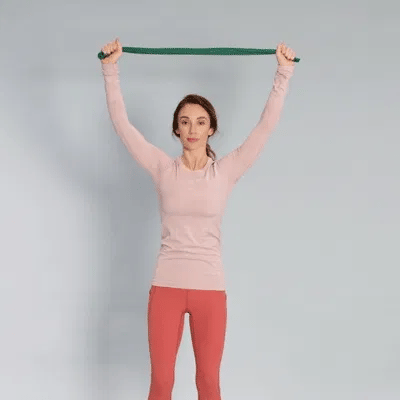
- Stand firmly with your feet shoulder-width apart.
- Hold the band with both hands, palms facing up, and extend your arms overhead.
- Pull the band apart by moving your hands away as you lower your arms to shoulder height.
- Hold the position for a few seconds, then bring your hands back together overhead.
- Perform 12-15 reps for 2-3 sets.
7. External Rotation

- Secure the resistance band to an anchor at waist height.
- Stand perpendicular to the anchor and hold the band handle with the hand farthest from the anchor.
- Keep your arm extended and swipe from top to bottom.
- Hold and slowly return to the starting position.
- Do 10-12 reps before switching to the other arm.
8. Horizontal Arm Extension
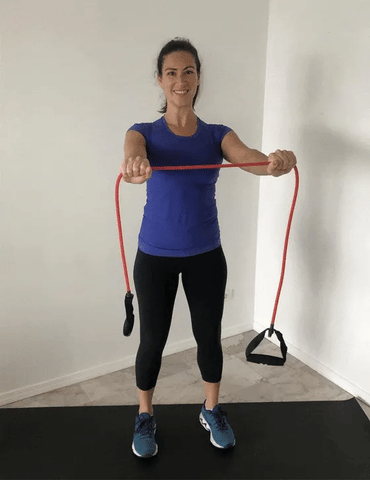
- Stand with your feet shoulder-width apart.
- Hold the band with your hands horizontally extended in front of you.
- Keep your elbows unlocked, spine straight, and core engaged as you pull the band apart as far as possible, squeezing your shoulder blades.
- Hold for a moment before you return your arm to the starting position.
- Do 12-15 reps for 2-3 sets.
9. Internal Shoulder Rotation

- Secure the resistance band at waist height.
- Standing with your side to the anchor point and feet hip-width apart, hold the band handle with the hand closest to the anchor.
- Keep your elbow close to your side and your forearm parallel to the ground.
- Rotate your forearm inward across your body.
- Hold for a few seconds, then slowly return to the starting position.
- Perform 15 reps for 2-3 sets on each side.
10. Rear Arm Extension
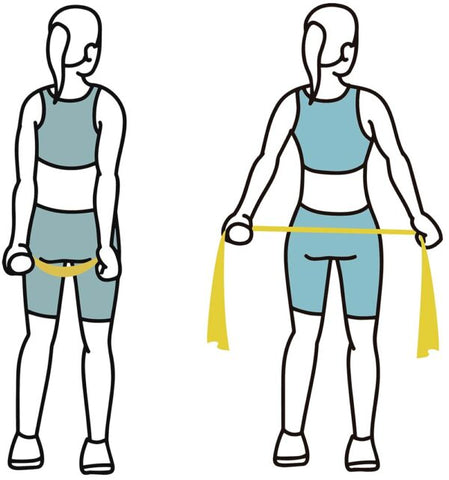
- Stand with your feet shoulder-width apart.
- Hold the band with arms straight behind your back.
- Keep elbows unlocked as you pull the band apart.
- Keep your back straight and core engaged.
- Slowly return to the starting position.
- Do 3 sets of 12-15 reps each.
11. Outward Shoulder Rotator
- Stand firmly with your feet shoulder-width apart.
- Holding onto the resistance and your elbow bent at a 90-degree angle, sticking to your side, keep your forearm parallel to the ground.
- Rotate your forearm outward away from your body, keeping them parallel to the ground throughout the movement. Ensure your shoulders are natural and not hunched up or forward.
- Return to the starting position.
- Do 10-12 reps for 2-3 sets.
12. Bent Over Row

- Stand on the center of the resistance band with your feet hip-width apart.
- Bend at the waist, keeping your back straight.
- Pull the band toward your lower rib cage by bending your elbows, firmly holding on to the resistance band handles, and your arms extended toward the ground.
- Hold before you straighten your arms to return to the starting position.
- Aim for 10-15 reps for 2-3 sets.
13. Diagonal Shoulder Flexion

- Anchor the resistance band at your ankle height.
- Stand perpendicular to the anchor point.
- Hold the band handle with the hand farthest from the anchor.
- Pull the band diagonally across your body, extending your arm upward.
- Hold the position for a few seconds.
- Return to the starting position slowly.
- Do 12-15 reps for 2-3 sets on each side.
14. Kneeling Row
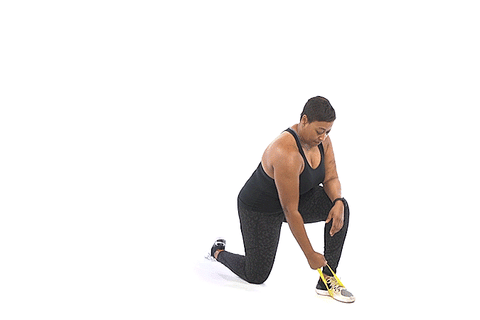
- Start in a half-kneeling position with the resistance band wrapped around the front feet.
- Hold the band ends in one hand.
- Pull the band toward your lower rib cage by bending your back straight slightly; lean over the front foot by bending your elbows.
- Hold a moment, then extend your arms to return to the starting position.
- Do 12-15 reps for 2 sets.
15. Lat Pulldown
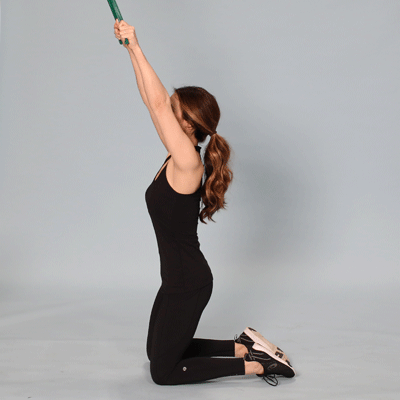
- Secure the resistance band overhead.
- You can kneel or stand facing the anchor point while holding the band handles.
- Start slowly pulling the band down toward your chest, keeping your elbows close to your body.
- Extend your arms to return to the starting position in a controlled movement.
- Aim for 12 reps for 2-3 sets.
Precautions before starting resistance band exercises
The shoulder band rehab exercises we listed above are low-impact, yet you must still practice some precautions to ensure safety and maximize the benefits.
If you have any existing shoulder injuries, consulting a healthcare professional such as a physical therapist or orthopedic specialist is mandatory. They can tell you whether resistance bands for shoulder rehab are suitable for you or not.
Start with lower resistance if you are new to resistance band exercises or are recovering from a shoulder injury. Focus on proper form and avoid overexertion.
You can gradually increase the resistance levels of shoulder rehab exercises with bands as your strength and comfort with the exercises improve. It is a progressive approach that ensures you continue strengthening your shoulder muscles without risking an injury.
Warm-up exercises for shoulder
Before you start with any rotator cuff resistance band exercises, getting the blood in your muscles around shoulder joints flowing is essential. A warm-up session helps prepare your muscles and joints for the upcoming physical activity.
Here are three effective warm-up exercises for the shoulder:
1. Shoulder Circles

- Stand with your feet shoulder-width apart.
- Extend your arms to the sides.
- Slowly start moving your arms in circles in a controlled manner.
- Do 10 reps before you reverse direction.
2. Scapular Push-Up
- Get into a push-up position. You can also go down on your knees if you find it difficult to extend your body fully.
- While maintaining the push-up position, slowly push your shoulder blades apart (protract) and then squeeze them together (retract).
- Do 15-20 reps.
Which type of resistance bands should I get for shoulder rehab exercises?
The choice of resistance bands for shoulder rehab depends on your fitness level. The band must offer the right resistance level to work out your shoulder muscles. While several resistance bands are available, resistance tubes with handles provide a more comfortable grip and can be great for shoulder exercises.

LIT AXIS smart resistance bands are revolutionary bands with built-in sensors to track your metrics and customize your workouts based on your fitness level and goals. You can use these resistance bands for shoulder pain.
~[[lit-axis-cherry]]
These bands are particularly useful for physical therapy and rehabilitation due to their data-driven approach that tracks your reps, resistance loads, muscle imbalance, and more.
Conclusion
Shoulder rehab exercises with bands are an effective, injury-safe way to regain strength, mobility, and shoulder function. When done correctly with supervised workouts such as LIT AXIS' built-in metrics monitoring, these exercises can significantly aid your recovery and improve overall shoulder health.
FAQs
1. Is it safe to use resistance bands for shoulder exercises during rehab?
Yes, resistance bands are actively used for physical therapy because they offer low-impact alternatives for free weights that allow proper form for shoulder rehab.
2. What precautions should individuals with shoulder injuries take before starting a resistance band workout?
Always consult a healthcare professional if you have a shoulder injury, start with low-impact shoulder dislocation exercise with band, and prioritize proper form before you move to more intense workouts.
3. Are there any specific shoulder conditions that require modifications in resistance band exercises?
Conditions like rotator cuff tears, shoulder impingement syndrome, adhesive capsulitis, and labral tears may require modifications or avoidance of specific exercises.
4. Can resistance band exercises help prevent future shoulder injuries?
Yes, shoulder rehab exercises with resistance bands improve the strength of shoulder muscles, improving stability. It helps prevent future injuries.
5. How often should someone with a shoulder injury perform resistance band exercises?
The frequency depends on the severity of the injury, which is why it is best to consult a physiotherapist who can create a customized exercise routine.
6. How long does it typically take to see improvements in shoulder strength through resistance band exercises?
The outcome varies from person to person, depending on their fitness and injury status. However, consistency and following a proper plan are essential for positive improvements.
7. Can resistance band exercises be integrated with other forms of shoulder rehabilitation, such as physical therapy?
Resistance bands can complement traditional physical therapy by providing a low-impact routine to enhance shoulder recovery and strength.


